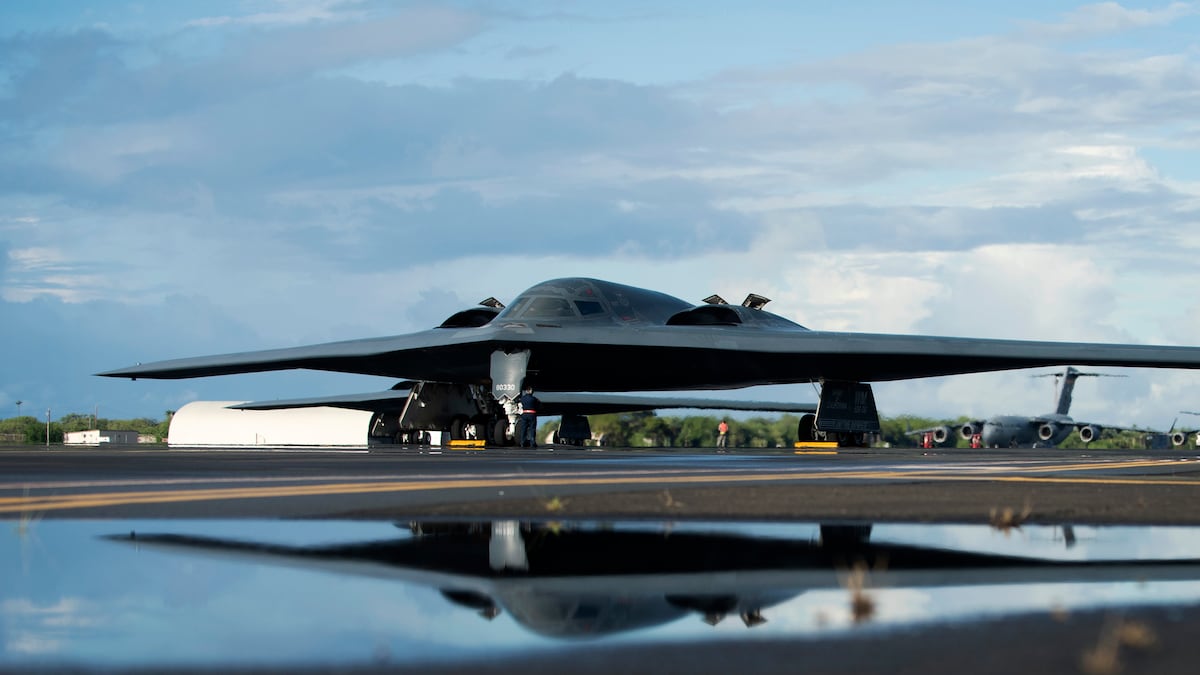



A hydraulic system failure caused a B-2 Spirit stealth bomber’s landing gear to collapse in 2022, which sparked a ferocious fire that led to the aircraft’s retirement, an accident investigation board found.
The accident investigation report, which the Air Force released Tuesday, also faulted a design flaw with the B-2’s landing gear and a firefighter commander’s mistaken decision not to use fire suppressant foam right away.
The B-2, which was from the 509th Bomb Wing at Whiteman Air Force Base, Missouri, and dubbed the “Spirit of Hawaii,” took off the morning of Dec. 10, 2022, and later began to fly back to base without incident.
As the bomber approached Whiteman’s runway, its pilot began to lower the landing gear. All three landing gear doors began the unlocking process normally, but then a valve coupling within the right landing gear’s system failed, according to the report, leading to a rapid loss of hydraulic fluid and pressure in the main hydraulic system.
Warning lights began to appear in the bomber’s cockpit, and its onboard computer switched to a backup system, which attempted to repressurize the lines needed to unlock the right landing gear. But the backup system itself started rapidly losing fluid and pressure, and the computer began repeatedly switching between the primary and backup systems, looking for a way to open the landing gear.
The bomber’s pilot conducted an emergency landing gear extension to lower the right landing gear, which was finally successful, the report said. The air crew alerted the tower at Whiteman that it had an in-flight emergency caused by a hydraulic failure and needed to land. Whiteman’s controller began to prepare the base for a crash situation and called up firefighters, ambulance services and other rescue workers.
But when the bomber touched down, shortly before 2:30 p.m., the left landing gear failed to stay locked in position and collapsed under the plane’s weight.
When the pilots realized the right landing gear was in the air and the plane was dragging to the left, the main pilot took over and tried to pull the rudder hard to the right to keep the bomber on the runway.
The pilot “st[ood] up out of [the] seat to give it everything [he] had on the right brake,” the report said.
The plane’s left wing dragged thousands of feet along the runway, according to the report. The taxiway’s concrete surface shredded the left wingtip to the point that a fuel tank ruptured and a fire ignited.
The bomber ultimately came to a rest nearly a mile beyond the point where the landing gear collapsed, leaving a trail of flaming fuel extending from the left wingtip. Both pilots were uninjured, and they safely exited the aircraft without ejecting.
Meanwhile, the incident commander responding to the crash ordered firefighters to only use water to put out the fire and not a special foam, the report said, because he incorrectly believed the foam was only to be used against a fire as a last resort. After about three and a half minutes, he authorized the use of the foam, which is a more effective fire suppressant than water when trying to put out a flammable liquid.
Once the external fire had been somewhat suppressed – but not extinguished – firefighters began to approach the aircraft to put out the internal fire with hand-held water hoses. But at about 3 p.m., about 30 minutes after the bomber touched down, a fuel tank within the plane’s left wing exploded, prompting trucks to once again attack the fire with suppressant foam.
Ten minutes after the explosion, as firefighters again tried to get closer to the plane, a second fuel tank on the bomber’s left-hand side detonated with a larger explosion, hurtling a section of aircraft skin roughly six feet wide into the air. It almost hit some firefighters and flung debris around the crash site.
This second explosion helped expose the internal fire, allowing firefighters to directly spray water onto the fire. The fire was completely extinguished about one hour after the crash and initial eruption of flames.
The investigation board found that the main cause of the crash was a hydraulic coupling valve failure. A design flaw with the B-2’s main landing gear also substantially contributed to the crash, the report said, and the incident commander’s decision not to use the fire suppressant foam right away allowed flames to spread and caused more damage to the aircraft.
The crash caused about $27,500 in damage to the runway, according to the report. The left wing and landing gear sustained more than $300 million in damage, the report said, but the Air Force ultimately concluded the plane was too damaged to make a repair worthwhile and retired it.
Each B-2 cost the Air Force about $1.2 billion in the 1990s, when the bombers entered service. The service now has 19 remaining B-2s, which are expected to retire in the early 2030s.
Stephen Losey is the air warfare reporter for Defense News. He previously covered leadership and personnel issues at Air Force Times, and the Pentagon, special operations and air warfare at Military.com. He has traveled to the Middle East to cover U.S. Air Force operations.
